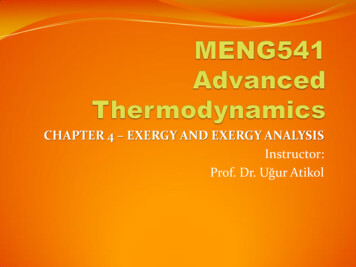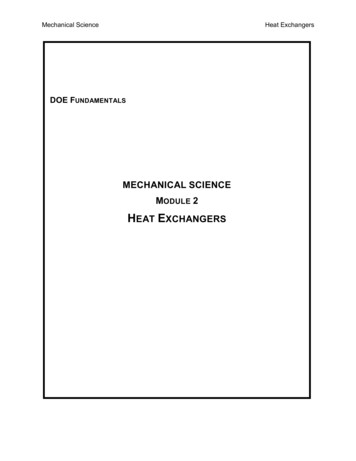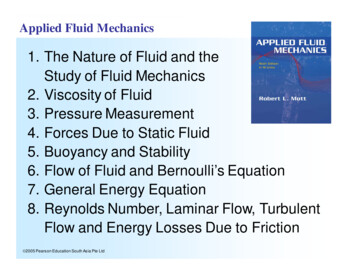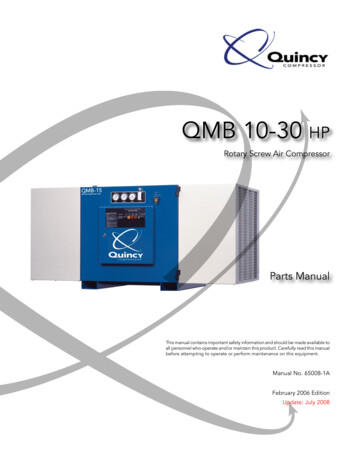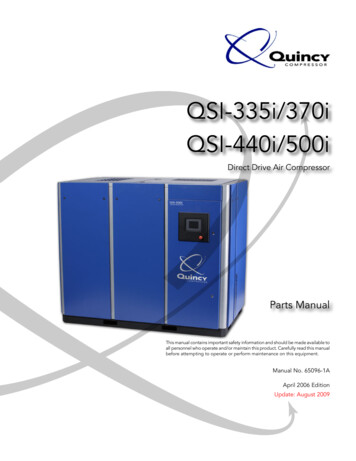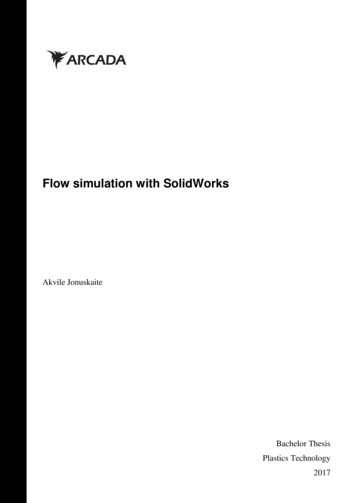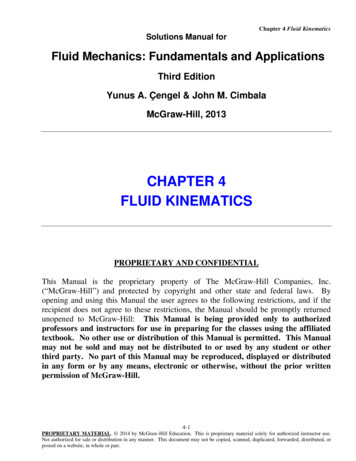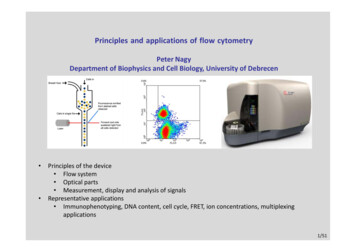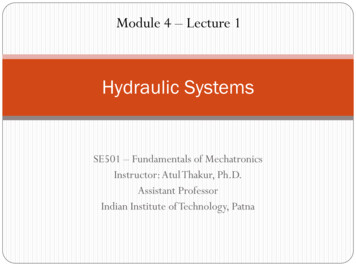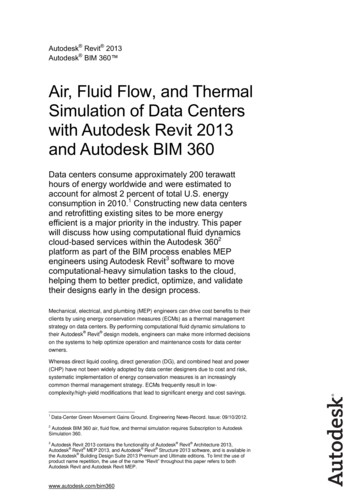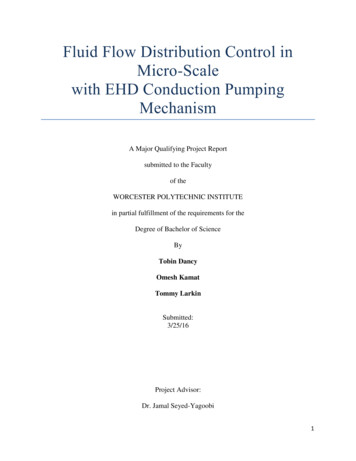
Transcription
Fluid Flow Distribution Control inMicro-Scalewith EHD Conduction PumpingMechanismA Major Qualifying Project Reportsubmitted to the Facultyof theWORCESTER POLYTECHNIC INSTITUTEin partial fulfillment of the requirements for theDegree of Bachelor of ScienceByTobin DancyOmesh KamatTommy LarkinSubmitted:3/25/16Project Advisor:Dr. Jamal Seyed-Yagoobi1
AbstractElectrohydrodynamic (EHD) conduction pumping technology utilizes the interactionbetween an applied electrical field and dissociated ions within a dielectric fluid to generate a netbody force within the working fluid, which results in a net flow in a desired direction. EHDconduction pumps have noticeable benefits when compared to their traditional mechanicalcounterparts due to their low vibration and noise generation, low power consumption, and abilityto operate in microgravity. EHD conduction pumps provide intelligent flow control via theirability to vary the electric field voltage applied to their electrodes. Flow distribution controlusing EHD conduction pumps has been previously examined in macro- and meso-scaleconfigurations confirming effective redistribution of flow and recovery from mal-distribution inboth single and two-phase flows. The purpose of this Major Qualifying Project was to study theuse of EHD conduction pumps in controlling single phase flow distribution through parallelmicro-channels, 500 microns tall, using upstream micro-scale EHD pumps. Voltage applied tothe micro-scale EHD conduction pumps ranged between 0-1500 volts. The working fluid used inthese experiments was the refrigerant HCFC-123, operated at ambient conditions.2
AcknowledgementsWe would like to first thank Worcester Polytechnic Institute and the MechanicalEngineering Department at WPI for providing us with the technological and financial resources,as well as the educational background, required to complete this project. The team would like tooffer special thanks to Michal Talmor and Lei Yang, the PhD students in WPI’s Multi-ScaleHeat Transfer Laboratory, for their never ending support and guidance throughout each step ofthis project. Most of all, we would like to thank Professor Jamal Seyed-Yagoobi for advising theproject and providing us with guidance and encouragement throughout the process. We wouldalso like to thank David Richard and Andrew Barakos of Nova Biomedical for their assistance inthe manufacturing of our evaporator assembly. Lastly, we would like to acknowledge theprofessional vendors we have had the pleasure to work with: McMaster-Carr, Speedy Metals,Ultimate Plastics, and Omega.3
Table of ContentsAbstract . 2Acknowledgements . 3Table of Contents . 4Table of Figures . 8Table of Tables . 9Chapter 1: Introduction . 101.1 Overview of Electrohydrodynamics . 101.2 Project Overview . 121.3 Primary EHD Pumping Mechanisms . 131.3.1 Ion-Drag Pumping. 131.3.2 Induction Pumping . 141.3.3 Conduction Pumping. 141.4 Potential Applications . 16Chapter 2: Methodology and Experimental Setup . 182.1 Overview . 182.2 Requirements . 182.3 Design . 202.3.1 EHD Conduction Pump . 212.3.2 Evaporator Design. 21Constraints . 22Initial Design . 23Final Design . 252.3.3 Initial Calculations . 28Pressure Drop . 28Evaporator Heat Transfer . 31Condenser Length . 332.4 Evaporator Manufacturing . 362.5 Experimental Loop Assembly . 372.5.1 Evaporator . 38Prepping the EHD Pump . 404
Powering the EHD Pump . 41Prepping for the Evaporator . 43Manifolds . 442.5.2 Condenser . 462.5.3 Mechanical Pump. 462.5.4 Reservoir . 472.6 Sensors Configuration and Calibration . 482.6.1 Flowmeters . 492.6.2 Differential Pressure Transducers . 512.6.3 Absolute Pressure Transducer . 532.6.4 Thermocouple Probes . 532.7 Data Acquisition . 542.7.1 Electrical and Grounding . 542.7.2 LabVIEW . 562.8 Experimental Preparation. 572.8.1 Leak Testing. 572.8.2 Methods of Leak Testing . 582.8.3 Methods of Leak Correction . 592.8.4 Charging the Reservoir . 592.8.5 Pulling a Vacuum . 612.8.6 Filling the Experimental Loop . 62Experimental Matrix . 63Variable Conditions and Ranges . 64Basic Experimental Procedure . 64Experiment I: Static Condition . 65Experiment II: Pump Performance . 65Experiment II: Equal Distribution to Maldistribution . 66Experiment III: Maldistribution to Equal Distribution . 67Chapter 3: Results and Discussion . 683.1 Experiment I: Static Conditions . 683.2 Experiment II: Dynamic Pump Performance Test . 693.3 Experiment III: Equal Flow to Maldistribution . 703.4 Experiment IV: Maldistribution to Equal Distribution . 725
3.5 Potential Causes of Error . 72Conclusion . 74References . 75Appendices. 77Appendix A: Assembly Loop Solid Models . 77Full Loop Assembly . 77Section 1: Evaporator Side. 77Section 1: Evaporator Side – EHD Pumps . 78Section 1: Evaporator Side – Flowmeters . 78Section 1: Evaporator Side – Evaporator . 79Appendix B.1: Differential Pressure Transducers Calibration Curves . 80Differential Pressure Transducer 1 . 80Differential Pressure Transducer 2 . 80Differential Pressure Transducer 3 . 81Differential Pressure Transducer 4 . 81Appendix B.2: Flowmeters Calibration Curves . 82Flowmeter 1 . 82Flowmeter 2 . 82Appendix C.1: LabVIEW Block Diagram . 83Appendix C.2: LabVIEW User Interface . 84Appendix D.1: Thermocouple Probe Configuration . 85Appendix D.2: Flowmeters Configuration. 85Appendix D.3: Differential Pressure Transducers Configuration . 85Appendix D.4: EHD Pump Voltage/Current Supply Configuration . 85Appendix E.1: Experimental Test Curves. 86Static Condition – Trial 1 . 86Static Condition – Trial 2 . 86Static Condition – Trial 3 . 87Pump Performance – Trial 2 . 87Static Condition – Trial 3 . 88Equal Distribution to Maldistribution . 88Appendix F: Physical Properties of R-123 . 89Appendix G.1: Loop Pressure Drop MATLAB Calculations . 906
Appendix G.2: Evaporator Pressure Drop MATLAB Calculations. 93Appendix G.3: Length of Condenser MATLAB Calculations . 987
Table of FiguresFigure 1: Dissociation and Recombination of Molecules. . 15Figure 2: Formation of Heterocharge Layers [1]. . 15Figure 3: EHD Conduction Electrode Configuration [8]. . 16Figure 4: Loop Assembly Schematic. . 20Figure 5: EHD Conduction Pump with Electrodes [14]. . 21Figure 6: Initial Micro-channel Chip Model. . 23Figure 7: Initial Evaporator Assembly Model. 24Figure 8: Final Teflon Micro-channel Chip Model. 25Figure 9: Final Evaporator Assembly Model. . 27Figure 10: Moody diagram [9]. . 30Figure 11: Hi-Density Cartridge Heater (Omega). 32Figure 12: Evaporator - Conduction heat transfer. . 33Figure 13: Top overview of the experimental setup. . 38Figure 14: Differential pressure transducers configuration. . 39Figure 15: Cleaning of the EHD Pumps. . 40Figure 16: Checking connection of electrodes to bus lines. . 41Figure 17: High voltage feedthroughs. . 42Figure 18: Complete assembly of the EHD pumps. 43Figure 19: Manual tube bender. . 44Figure 20: Manifold attached to the evaporator section. . 45Figure 21: Condenser section. . 46Figure 22: Mechanical pump section. . 47Figure 23: Reservoir section. . 48Figure 24: Sensirion flowmeters. . 49Figure 25: Calibration of Flowmeter 1. . 50Figure 26: Differential pressure transducer calibration apparatus. . 51Figure 27: Calibration of a Differential Pressure Transducer. . 52Figure 28: DAQ Board. . 55Figure 29: Conductivity testing for grounding. . 56Figure 30: Underwater leak testing method. . 58Figure 31: Elevated R-123 tank for filling the reservoir. . 61Figure 32: Genco HYVAC 7 pulling a vacuum. 62Figure 33: Static Condition: EHD Voltage vs. Differential Pressure across Branch 2, Trial 3 . 68Figure 34: Pump Performance Curve: EHD Voltage vs. Pump Performance (mL/min) in Branch 2, Trial3 . 69Figure 35: Pump Performance Curve, EHD Voltage vs. Differential Pressure in Branch 2, Trial 3 . 70Figure 36: Flow Distribution, Equal to Maldistribution: EHD Voltage vs. Differential Pressures inBranch 1&2 . 71Figure 37: Flow Distribution: Equal to Maldistribution, EHD Voltage vs. Flow Rate (mL/min) inBranches 1 & 2. 718
Table of TablesTable 1: Pressure drop and flow rates through each section. . 31Table 2: Temperature of Condenser vs. Length. . 35Table 3: Locations of the Thermocouple Probes. . 54Table 4: Experimental Variables. . 63Table 5: Pump Performance Experimental Matrix. 65Table 6: Pump Performance Experimental Matrix. 65Table 7: Equal to Maldistribution Experimental Matrix. . 66Table 8: Mal to Equal Distribution Experimental Matrix. . 679
Chapter 1: Introduction1.1 Overview of ElectrohydrodynamicsElectrohydrodynamics, abbreviated as EHD, is the study of interactions between appliedelectrical fields and fluid flow fields. EHD technology is most prevalently used for pumping, inwhich the application of an electric field on a working fluid is capable of generating net flow.The three main types of EHD pumping which are enacted primarily by the Coulomb force areion-drag, induction, and conduction pumping, which vary in their methods of inducing charge inthe working fluid. The focus on this project is on EHD conduction pumping.The physics behind EHD pumping identifies three main forces which are most involvedin the interactions between the applied electric field and the working fluid, and which result in anet force applied to the fluid causing its motion. These EHD forces which are imposed on thefluid are the Coulomb, Dielectrophoretic (DEP), and Electrostriction forces, the sum of which isreferred to as the net body force, described by the net body equation as seen below [2].1𝐸 2 𝜖⃑⃑⃑⃑𝐹𝐸 𝑞𝐸⃑ 𝐸 2 𝜖 [𝜌 ( ) ]22 𝜌 𝑇Coulomb’s Law relates the Coulomb force on a point charge (F), to the charge density ofthe particle (q), and the strength of an applied electric field (E). This relationship is directlyproportional between the strength of the electric field and the body force on the particle such thatan increase in the applied electric field strength results in a higher force on the particle. This isexpressed mathematically by the equation:𝐹 𝑞𝐸The DEP force is determined by an applied electric field’s strength and a gradient of thefluid’s property known as permittivity, denoted as 𝜖, which describes an electromagnetic10
medium’s resistance to an applied electric field. In an isothermal application there is no gradientin the working fluid’s permittivity [1], such that the DEP force term is negligible in single phasefluid applications.The electrostriction force is dependent on the permittivity of the working fluid as well asthe fluid’s mass density (ρ), and the differential of the fluid’s permittivity against its massdensity as determined at a constant temperature. In a similar manner as the DEP force, singlephase isothermal applications do not experience permittivity gradients or significant changes indensity [3]. Thus the electrostriction force contributes to fluid flow on such a small level that itcan be neglected for single phase fluid applications, such that the net force felt by the fluid isonly significantly a result of the Coulomb force. Consequently in EHD experiments usingisothermal single phase fluid, such as those conducted for this report, the net body force equationcan be simplified as:⃑⃑⃑⃑𝐹𝐸 𝑞𝐸⃑11
1.2 Project OverviewThe purpose of this Major Qualifying Project was to study the use of EHD conductionpumps in controlling flow distribution through parallel micro-channels using micro-scale EHDpumps. This project also sought to the pave way for future research in observing the heat transfercapabilities of EHD conduction driven flow through micro-channels and the impact on flowdistribution control for applications in which the working fluid experiences phase change. A twophase capable loop assembly was designed and constructed in order to study the generation offlow and pressure via the micro-scale EHD conduction pumps.There are several advantages of EHD conduction pumps when compared to standardmechanical pumps. These pumps consume low amounts of power as they utilize high voltagesbut very low currents typically on the order of five hundred microamps or less, they require littleto no maintenance, are extremely lightweight, and involve no moving parts which avoids thesignificant generation of noise and vibrations found in typical mechanical pumps. EHDconduction pumps provide smart flow control in their systems via their ability to vary the electricfield voltage applied to their electrodes. The pumps are effective in both single and two-phaseflow conditions [1] and also have the ability to operate in microgravity conditions due to theiroperational independence from gravity [5] which makes them especially well-suited to aerospaceapplications.The results and conclusions from this study could directly impact a wide range ofengineering applications in fields which micro-scale EHD technology could revolutionize,particularly the booming aerospace and electronics industries. The micro-scale EHD conductionpumping studied in this project has huge potential to increase performance and efficiency in12
applications like microelectronics cooling, thermofluid system flow regulation, and low-gravityheat transfer enhancement.1.3 Primary EHD Pumping MechanismsEHD pumping is achieved by applying an electric field to a dielectric working fluid so asto achieve a net flow. There are three primary types of EHD pumping which are distinguished bythe method in which charges are introduced to the working fluid. Each technique is capable ofdifferent levels of pressure generation and can be suitable to various applications; additionallyeach has its own associated benefits and drawbacks.1.3.1 Ion-Drag PumpingThe first EHD flow generation phenomenon to be researched was EHD ion-dragpumping, the fundamentals of which centers on the fact that dielectric fluids can be pumped bythe injection of ions, which has been known for more than one hundred years. Ion-drag pumpinginvolves the use of a pair of electrodes, one of which is a sharp, charge-injecting source, referredto as an emitter, and the second which is an oppositely charged collecting electrode, referred toas a collector. When a strong electric field is established between this pair of electrodes, thecorona effect causes a discharge of ions from the emitter. The injected ions are pulled throughthe fluid along the electrical field lines from the emitter towards the oppositely chargedcollecting electrode [1], generating flow as a result of the particle drag against the adjacent fluid.The major issues with the use of ion-drag pumping are primarily related to deterioration in theelectrical properties of the working fluid and a dulling of the emitter electrode as it is dischargedinto the fluid. As the fluid’s electrical properties deteriorate there is a significant drop in13
efficiency as well as potential safety hazards related to continued operation of the pumpingmechanism.1.3.2 Induction PumpingEHD induction pumping is a flow generation method which is based primarily on theDielectrophoretic (DEP) force. As previously mentioned the DEP force is dependent upon agradient in the permittivity of the working fluid, which is most commonly imposed by nonuniform thermal conditions or a change of phase in the fluid. The presence of these thermalgradients can induce gradient in electrical conductivity in different regions of the fluid, andt
conduction pumps have noticeable benefits when compared to their traditional mechanical counterparts due to their low vibration and noise generation, low power consumption, and ability to operate in microgravity. EHD conduction pumps provide intelligent flow control via their ability to vary the electric field voltage applied to their electrodes.

